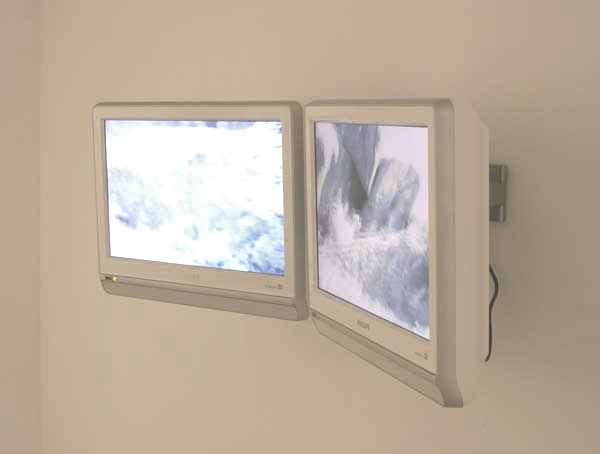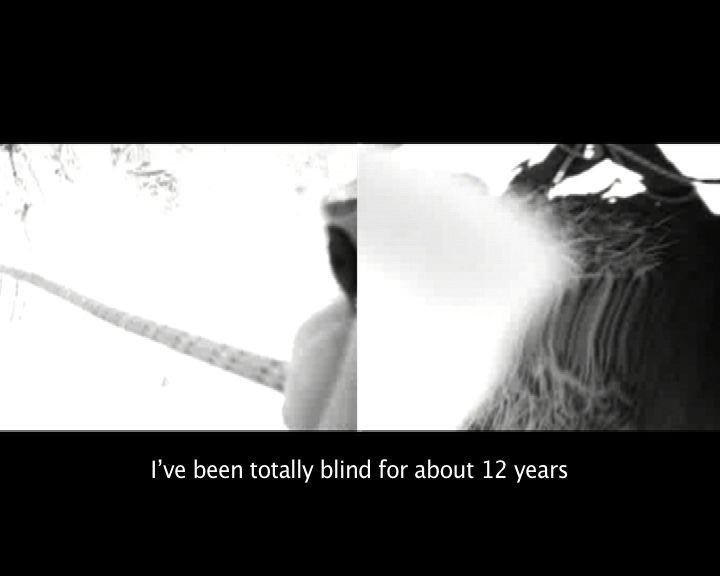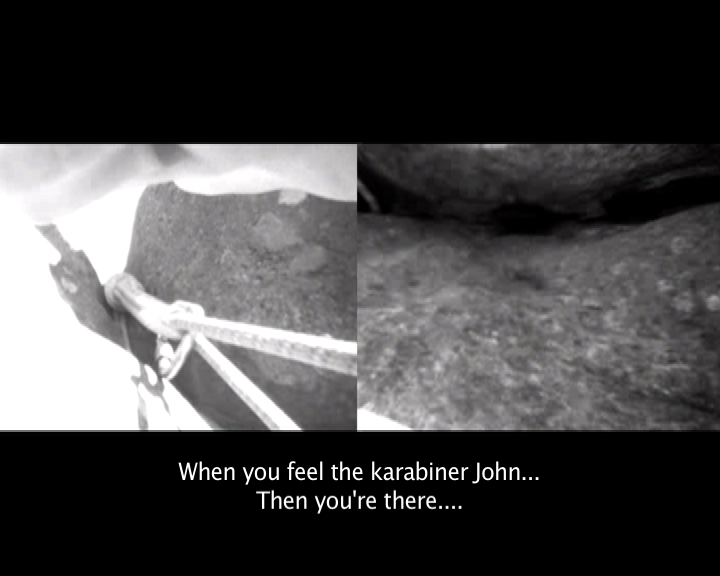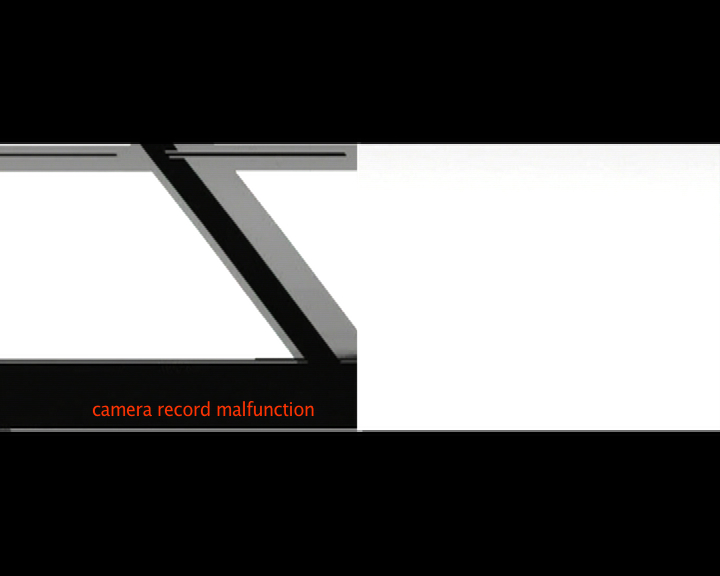Dolerite, Solarized Pigmatosis
Dolerite, Solarized Pigmatosis
Single Channel, Subtitled, SD Video
12min
2008
The Touchstone Test Piece blind climbing research project resulted in a number of artworks - the key one ironically being where the low grade mini video cameras which we developed for Johns fingers start to malfunction mid climb... The artwork is: Dolerite, Solarized Pigmatosis.
This work develops from a malfunction of the finger tip footage of a climb with John (a blind man) in Donegal at Dumore Head. The black and white footage is taken from just the finger cameras and is very abstracted because of the sunny day which solarized parts of the footage – making the sun itself appear black. It is in real-time and is approximately 12minutes long. During this climb the cameras started to malfunction on the short descent poetically adding to the sense of visually trying to record a physical or tactile experience.
This resulted in a really graphic transformation of the footage. With this climb these cameras on his left and right hands first solarise in the bright sunlight then judder in and out of action as they malfunction resulting in a move from the black and white up close topographic footage (kind of like the luna landscape) to abstract patterned video footage.
Funded by the AHRC Landscape and Environment programme
AHRC website http://www.landscape.ac.uk/
This artwork has been shown at:
Dan Shipsides screenings: Abrons Art Center New York,
The Munter Hitch. Two person show with Seamus Harahan. GTgallery, Belfast.
Embedded. Group show. Gimpel Fils. London. Curated by David Waterworth.
Echo Valley / A Guiding Dilemma Solo exhibition. Void Gallery. Derry.
Also show as a twin screen work.

This Landscape Text is of reference to this work
No Fear: Landscape [5]
In terms of climbing – working as a physiotherapist doesn't give you good body awareness – but I think that doing something actually bodily, such as Tai Chi – those things give you body awareness. You see physiotherapy can give you all the theory – and we tend to break things down into its component parts and talk about muscles, joints and the anatomy – the nitty gritty. But to have an actual sense within yourself of how to move I think is a matter of practice, familiarity and I suppose the enjoyment of doing it.
You tune into it.
I wouldn't have fear of climbing – and it probably helps not to have any idea of what 20metres looks like from above. So long as it feels safe I can enjoy climbing – I don't have any fear. Ignorance is bliss.
When I mention to people I've been climbing the response is sort of vaguely horrified – that a blind person would be up at that height. But that's not an issue. I mean it's a safe procedure, you know with the ropes and anchors and all the rest of it.
That's common with anyone – sighted or not. There's an assumption that there's great risk – but in reality – done with some expertise and experience - the risk it's managed so you can get into pretty exciting places with relatively low risk. But it's interesting that someone with sight – a novice – even with the ropes all set up – would often get scared at height – say 20metres…. Whereas you didn't.
Well I have literally no sight at all - so I can't see! It doesn't come into my mind. The only time I'm scared of heights is in my dreams.
That's interesting.
Well it's a common dream if you're stressed or worried – often there's a falling situation in your dreams.
I remember the first time we climbed at Culdaff – that really cold and wet day. I'd climbed the route and then belayed you up it to join me. Then at the top you were sat right on the edge of this drop and I was thinking should I get you to move back – but I didn't. You were roped and belayed so it was completely safe but really exposed – but you were as happy as Larry – completely composed in a place where most people would have been at least a little edgy.
Well - I know when I've been on a climb – if I haven't felt safe…then I really haven't felt safe – so obviously the conditions or context at that point must have put me at ease!
You shouldn't have told me that about the edge….
…..
As we were starting climbing some of your knowledge of the body as a physiotherapist seemed to come into our conversation. You mentioned the sense in your joints.
Oh your proprioceptors – yeah – there are sort of little sensors in your joints which just allow you to know – allow your brain to know – where your body is in space and they just feed in automatically to your postural awareness – so if someone is in the dark they know automatically that the knee is bent – regardless of the position or placement of the foot. You know so there's a joint sense.
I see - so they feedback information regarding posture and adjusting balance in relationship to terrain.
Well sort of and sort of pleasure and pain – at least ‘like' or ‘not like' in some sense. They will inform you when the movement is becoming over-balanced as such forth. That's why when you've sprained an ankle you need to retrain these sensors as well or as much as the muscle tissue.



